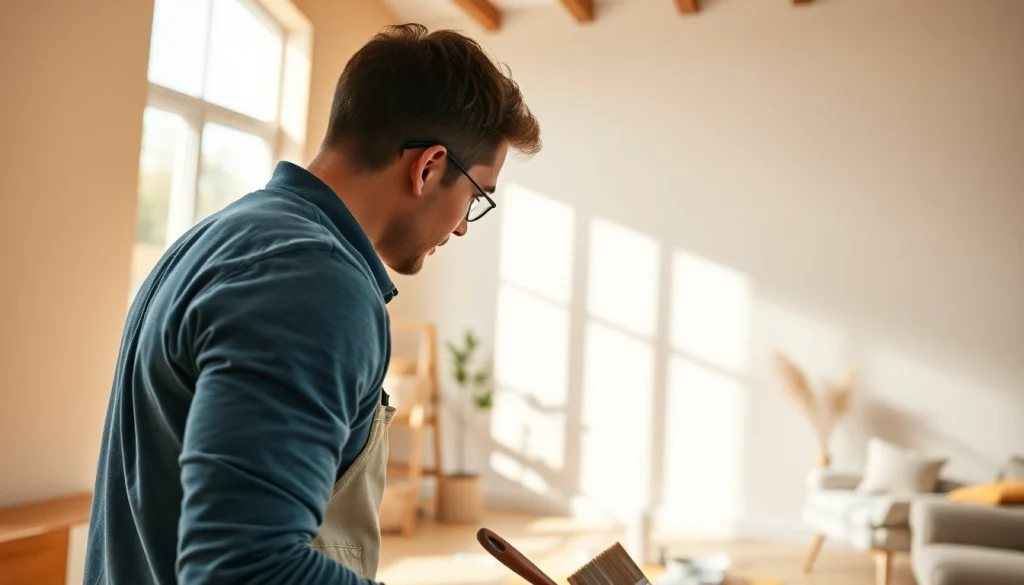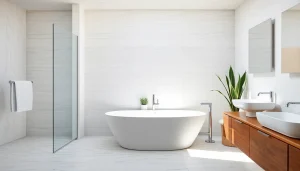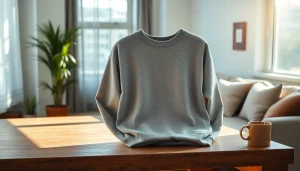Essential Guide to Interior Painting: Tips, Techniques, and Cost Insights

Understanding Interior Painting
What is Interior Painting?
Interior painting refers to the process of applying paint to surfaces within a building, such as walls, ceilings, and trim. This practice enhances the aesthetic appeal of indoor spaces while also providing protection to the underlying materials. Whether you’re refreshing an old room or completely revamping your home’s interior design, interior painting is a fundamental step in achieving a desired look and feel.
Common Interior Painting Styles
Interior painting styles vary widely, reflecting personal tastes and current design trends. Here are some popular styles:
- Minimalism: Characterized by neutral colors and simplicity, often using only one or two shades throughout the space.
- Accent Walls: A striking color or pattern on a single wall to create a focal point against more muted surrounding walls.
- Two-Tone Paint: Combining two different colors within the same wall, often with a dividing line, gives a modern touch.
- Textured Finishes: Techniques like sponging or rag rolling can add depth and character to a flat surface.
- Faux Finishes: Imitating the look of other materials like marble or wood can elevate the overall design.
Benefits of Professional Interior Painting
While DIY interior painting projects can be fulfilling, hiring professional painters can ensure a higher quality finish and save time. The key benefits include:
- Expertise: Professionals bring years of experience, ensuring quality and consistency throughout the project.
- Time Efficiency: Trained painters can complete jobs faster due to their skill and access to the right tools.
- Proper Prep Work: Professionals thoroughly prepare surfaces, ensuring better paint adhesion and a longer-lasting finish.
- Safety: Professionals understand safety protocols and use appropriate equipment to minimize risks during the job.
Preparing for Your Interior Painting Project
Choosing the Right Colors
The color you choose for your interiors can significantly impact the mood and perception of space. Factors to consider include:
- Room Function: Consider the purpose of the room. Soft, calming colors work well in bedrooms, while vibrant hues can energize living areas.
- Lighting: Natural and artificial lighting can alter the appearance of paint colors; test samples in the actual space before committing.
- Color Psychology: Different colors evoke different feelings. For example, blue promotes tranquility, while yellow creates a cheerful environment.
Essential Tools and Materials
To conduct a successful interior painting project, having the right tools is crucial. Here’s a list of essentials:
- Paint: Choose quality paints that suit your finish wishes—flat, satin, or gloss.
- Brushes and Rollers: Invest in quality brushes and rollers tailored for the type of paint you are using.
- Paint Trays: A sturdy tray is necessary for even distribution of paint.
- Drop Cloths: Protect floors and furniture from spills and splatters with durable drop cloths.
- Painter’s Tape: To achieve clean edges and lines on trims, doors, and window frames, painter’s tape is indispensable.
Surface Preparation Techniques
Proper surface preparation is key to achieving a smooth and even finish. Here are essential steps to follow:
- Cleaning: Remove dust, dirt, and grease from the walls to ensure paint adheres properly.
- Repairing: Patch any holes or cracks with spackle and sand the surface for an even finish.
- Priming: Apply a coat of primer especially on bare surfaces, or when painting over dark colors, to improve paint adhesion and coverage.
Expert Techniques for Interior Painting
Best Practices for Applying Paint
Applying paint effectively ensures a polished look that lasts. Key practices include:
- Start from the Top: Always begin painting with the ceiling, followed by walls, and finishing with trim and baseboards.
- Use Long, Even Strokes: Consistent strokes can prevent visible brush marks or roller lines.
- Maintain a Wet Edge: Keep a ‘wet edge’ to avoid lap marks by ensuring you overlap the previous stroke with wet paint.
Learning Different Painting Techniques
Familiarizing yourself with various painting techniques can enhance your project efficiency. Some noteworthy techniques include:
- Rolling: Ideal for large flat areas, ensure even pressure and consistent movement.
- Cutting-In: Use a brush to paint edges along ceilings, corners, and trim before rolling on main colors.
- Sponging: This technique adds texture and can be utilized as a decorative effect on walls.
Using Professional-Grade Tools Effectively
The right tools make a world of difference. Here are some tips to use your tools effectively:
- Brush Care: Clean brushes thoroughly after use to maintain their shape and prolong their lifespan.
- Roller Covers: Select the correct nap length for your surface texture; a longer nap is suitable for rough surfaces.
- Sprayers: For larger projects, consider using paint sprayers for faster application, ensuring to master the technique for even coverage.
Calculating Costs of Interior Painting
Factors Influencing Interior Painting Costs
The overall cost of an interior painting project can vary significantly based on several factors:
- Size of the Space: Larger rooms will naturally require more paint and time, increasing overall costs.
- Paint Quality: High-quality paints may have a higher initial cost but offer better coverage and durability.
- Type of Finish: Specialty finishes (e.g., textured, satin) can add to labor costs due to the complexity involved.
Average Cost Breakdown by Room
Here’s a typical cost breakdown for interior painting by room size:
| Room Type | Size (sq.ft.) | Estimated Cost (Labor Included) |
|---|---|---|
| Bathroom | 20 – 100 | $60 – $400 |
| Bedroom | 200 – 310 | $600 – $1,240 |
| Kitchen | 200 – 360 | $600 – $1,320 |
| Living Room | 300 – 400 | $900 – $1,600 |
DIY vs. Hiring Professional Painters
Deciding between DIY painting and hiring professionals involves weighing costs against benefits:
- DIY: Potential cost savings but requires time, skill, and tools.
- Professional Painters: Higher upfront cost but typically results in better quality and longevity.
Post-Painting Care and Maintenance
How to Maintain Painted Surfaces
Once you have painted your interiors, maintaining them is pivotal. Regular care practices can help to prolong the life of your paint:
- Regular Cleaning: Use a microfiber cloth to gently wipe down walls to remove dust and fingerprints.
- Avoid Harsh Chemicals: Stick with mild soap and water to clean painted surfaces.
- Touch-Ups: Keep extra paint on hand for small touch-ups as needed.
Common Issues and How to Fix Them
Despite best efforts, issues can arise in painted surfaces. Here’s how to handle common problems:
- Peeling Paint: This commonly occurs due to moisture; scrape and sand the affected area and repaint.
- Color Fading: Direct sunlight can fade paint colors. Before repainting, consider using UV-stable paints for better longevity.
- Stains: Non-washable paints may stain. If this happens, consider repainting with a stain-resistant formula.
Updating Your Interior Painting Over Time
As trends change and personal tastes evolve, updating your interior painting can rejuvenate your living space:
- Periodic Reviews: Regularly assess your painted surfaces for wear, considering when it might be time to repaint.
- Trend Research: Stay informed about current color trends and techniques to keep your home stylish.
- Furnishings Update: Sometimes, changing the decor can influence painted surfaces, prompting a refresh or update.







